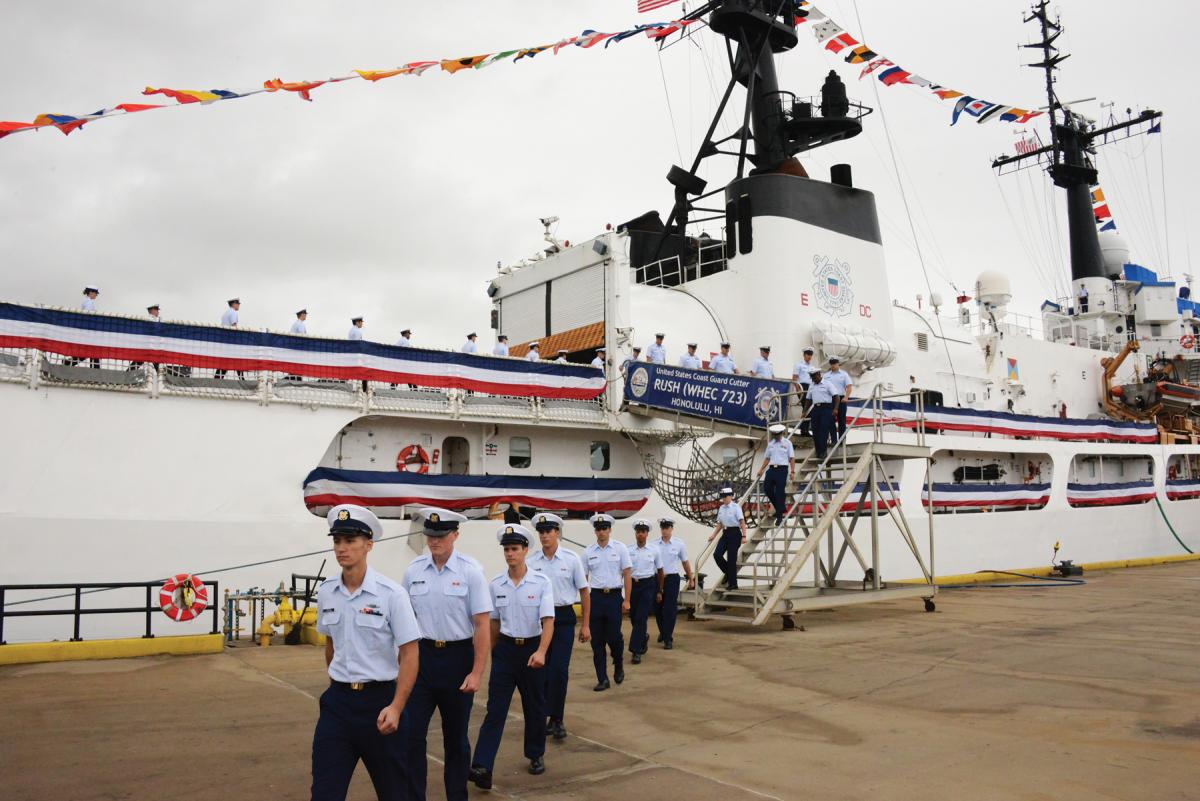
The Coast Guard must do more to prepare its people for the freshwater job market. U.S. Coast Guard / Melissa McKenizie)
The morning pipe shouts “Now reveille! Reveille! Reveille! Up, up all hands!” The day begins as the last one did, seven days away from our return to homeport. The smell of an 18-man crew berthing is overpowered by the sweet smell of freshly brewed coffee and seared bacon strips and scrambled eggs. I sit down to eat with the rest of the duty section, about ten minutes before I have to relieve the previous bridge watch.
I take a sip of my coffee and look around the mess deck. I see the boatswain’s mates at the next table and the electronic technicians, information system techs, and operation specialists at the table behind me. The machinery technicians and firemen sit in another corner, and at the far end of the mess deck I notice the senior petty officers. As I enjoy my breakfast, one thought lingers, and I have a strong feeling my shipmates have had the same thought: What will I do after I leave the service?
The Freshwater Transition
Some Coast Guard rating training programs provide members with skill sets that smoothly transition into an equivalent profession in the civilian sector. Most rates, however, lack the training and skills that would translate to a competitive résumé in the civilian world. Here are a few examples:
• A chief boatswain’s mate ensures successful operations throughout the patrol because of her expertise in maneuvering small boats. For the rest of the day she uses her leadership, judgment, and experience to manage a team of up to 20 sailors and junior boatswain’s mates in routine operations and work projects. In some units, she serves as the commanding officer of the ship. Finding a job as a civilian boat captain or deck supervisor, however, would prove difficult, even with all this experience.
• Coast Guard culinary specialists not only cook breakfast, lunch, and supper every day, but also manage the ship’s food inventory, organize balanced menus for the week, acquire the food, and maintain the food facility financial ledger. Some of them, with more than ten years of experience, are unable to credit their skills after the service though most would qualify as restaurant chefs in the civilian sector.
• On board a Coast Guard cutter, the administration of medical readiness, enforcement of sanitation standards, and prevention and treatment of disease and injury among a crew of 170 people (in some units more) rest in the hands of the independent duty health services technician, or “doc.” Health services technicians have the opportunity to apply to the highly competitive Interservice Physician Assistant Program, but only after obtaining a bachelor’s degree equivalent in biology (completed on the member’s own time). Health services technicians who do not benefit from this program and separate from the service, however, will not find equal skill-level professions because their skills and training do not translate into college credits.
These are just a few examples of what rated professionals serving in the Coast Guard will have to face when they leave the salt life and transition to freshwater.
From Mate to Apprentice
All crew members on board Coast Guard units contribute to mission success. With the proper application of transitioning programs, the civilian sector would benefit from service members’ skills. Many programs already exist for the transition to the civilian workforce, such as the Transition Assistance Program, the Call of Duty endowment, and other Veterans’ Administration programs and foundations. There are other programs that offer sailors the opportunity to earn professional certificates through a journeyman-level apprenticeship. Electrician’s mates and machinery technicians greatly benefit from these programs in the Coast Guard. But some sailors are left with little assistance, and this affects the attrition of those ratings populations.

Coast Guardsmen learn many skills while at sea and on shore, but there are few programs that translate these skills into college credits or competitive civilian-job résumés. (U.S. Coast Guard / Corinne Zilnicki)
Recent statistics indicate that unemployment in the United States is decreasing, but according to studies presented by Natalie Gross in a Military Times article, most veterans who have successfully been employed are underemployed. Jobs are available but are inadequate to the former service member’s skill set and expertise. This results in unfulfilling jobs that pay less and can place veteran families in economic hardship.
An apprenticeship program, such as the one presented in the United Services Military Apprenticeship Program, for all rated specialties that include professional certifications and other transition courses after separation could solve this problem. Another option would be expanding “A” school curriculums for more advanced skills and classes that would qualify for college credit. Not only could these measures increase Coast Guard enlistment, but they also could increase morale and boost the economy.
Invest in Sailors' Futures
An organization that invests in its employees stands to gain when it comes to productivity and progress. The same thing can be said of the United States. A country that invests in the men and women who defend and protect it will stand to gain economically. Every year, Navy sailors and Coast Guardsmen separate after completion of their service. Many of them retire to take care of their families and serve their local communities, focusing on other professional paths unrelated to their military careers. Other sailors separate from the service ready to apply their experience in a civilian equivalent profession, bringing their years of salty knowledge, energy, and technical expertise to the freshwater.
The Coast Guard must provide fair winds and following seas for the men and women separating from the service—who have earned their salt—by giving them the tools and support they need to succeed in civilian careers.


